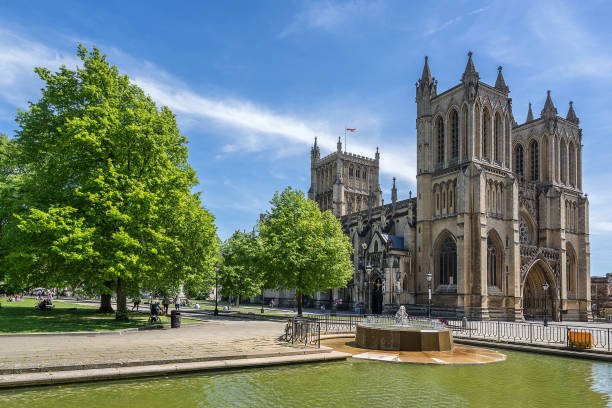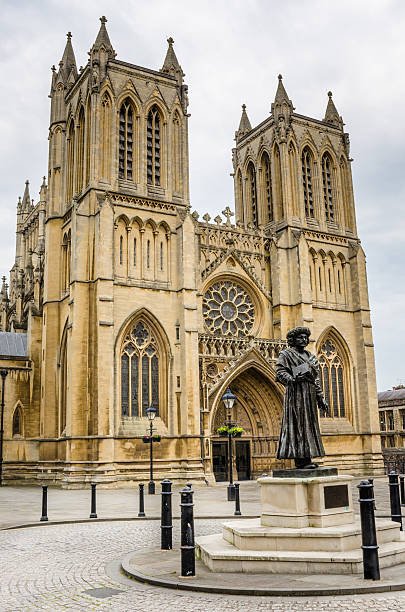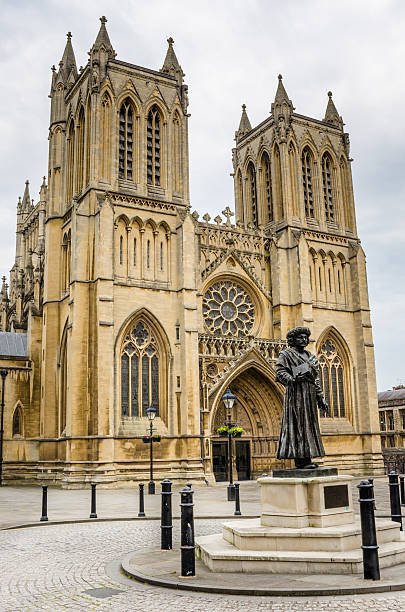Bristol Cathedral: A Timeless Treasure Historical Background
## Bristol Cathedral: The Best Place to Visit in the UK
**Introduction**
Bristol Cathedral, often hailed as the best place to visit in the UK, stands as a magnificent testament to the rich history and architectural splendor of Bristol. Situated in the heart of this vibrant city, the cathedral offers visitors a captivating glimpse into centuries of English heritage, blending Gothic grandeur with a living, active place of worship. From its intricate architecture and historical significance to its role in the community and cultural landscape, Bristol Cathedral encompasses everything that makes it an exceptional destination. This comprehensive blog will delve into why Bristol Cathedral is celebrated as the best place to visit in the UK, exploring its history, architecture, significance, and the myriad experiences it offers to visitors.
### Historical Evolution of Bristol Cathedral
**Origins and Medieval Foundations**
Bristol Cathedral’s origins trace back to the 11th century, marking it as one of the oldest and most historically significant structures in Bristol. The site initially served as a monastic community for Benedictine monks. The original abbey, founded by Robert of Gloucester, a prominent figure in the 12th century, was an important center for spiritual and educational activities in medieval England.
The transition from a Benedictine abbey to a cathedral occurred in 1542, during the Reformation under Henry VIII. The dissolution of the monasteries led to the reconstitution of the abbey as the Cathedral Church of the Holy and Undivided Trinity. This transformation marked a significant shift in the building’s role and purpose, cementing its place as a pivotal institution in the Church of England.
**The Gothic Revival**
The 19th century brought substantial renovations to Bristol Cathedral, which were part of the broader Gothic Revival movement. This period of restoration, led by Sir George Gilbert Scott, sought to restore and enhance the medieval architecture of the cathedral. Scott’s work included the restoration of the nave, the addition of intricate stained glass windows, and the renovation of the choir and transepts.
These renovations not only preserved the cathedral’s historical essence but also highlighted its architectural beauty, making it an even more compelling destination for visitors. The Gothic Revival style infused the cathedral with a renewed sense of grandeur, blending historical authenticity with Victorian artistry.
### Architectural Splendor
**Gothic Architecture and Design**
Bristol Cathedral is renowned for its impressive Gothic architecture, characterized by its pointed arches, ribbed vaults, and flying buttresses. The cathedral’s design reflects the pinnacle of medieval Gothic architecture, creating a majestic and awe-inspiring atmosphere.
One of the cathedral’s most striking features is its **nave**, which boasts an expansive, vaulted ceiling supported by slender columns. The intricate tracery of the stained glass windows, including the notable **East Window**, adds to the cathedral’s ethereal quality, allowing sunlight to cast colorful patterns on the interior stonework.
**The Chapter House**
The **Chapter House**, a vital component of the cathedral, is a marvel of medieval architecture. This octagonal room, with its intricate stonework and ribbed vaults, was originally used for meetings of the cathedral’s clergy. Its design exemplifies the gothic mastery of space and light, offering a serene and contemplative environment for visitors.
**The Cloisters**
The cathedral’s **Cloisters** are another architectural gem, providing a tranquil space for reflection and meditation. The cloisters feature beautifully carved stone arches and an impressive vaulted ceiling, creating a serene environment that contrasts with the bustling city outside. These spaces were traditionally used by monks for quiet contemplation and are now enjoyed by visitors seeking a moment of peace.
**The Chapter House and its Carvings**
Within the Chapter House, visitors will find an array of intricate stone carvings and sculptures. These include representations of biblical figures, saints, and various motifs, all meticulously crafted to enhance the architectural beauty of the space. The carvings serve both decorative and educational purposes, illustrating biblical stories and medieval craftsmanship.
### The Cathedral’s Role in the Community
**A Living Place of Worship**
Bristol Cathedral continues to serve as an active place of worship, with regular services and ceremonies that are central to its role in the community. The cathedral’s liturgical calendar includes daily prayers, weekly Eucharists, and special services for significant occasions, such as weddings, baptisms, and memorials. These services reflect the cathedral’s ongoing spiritual significance and its role as a focal point for the local Christian community.
**Educational and Cultural Activities**
In addition to its religious functions, Bristol Cathedral is a hub for educational and cultural activities. The cathedral hosts a range of programs and events designed to engage visitors of all ages. These include educational workshops for schoolchildren, historical tours for tourists, and cultural events such as concerts and art exhibitions.
The cathedral’s education department works closely with local schools and community groups to provide educational resources and activities that promote a deeper understanding of the cathedral’s history and heritage. These programs aim to foster a sense of connection to the cathedral and its role in the community.
**Community Engagement and Outreach**
Bristol Cathedral is actively involved in community outreach and engagement. It hosts a variety of events that support local charities, social causes, and community initiatives. These events include fundraising activities, community gatherings, and partnership projects with local organizations. By participating in these activities, the cathedral reinforces its commitment to serving the community and addressing contemporary social issues.
### Visitor Experience at Bristol Cathedral
**Guided Tours and Audio Guides**
To fully appreciate Bristol Cathedral’s historical and architectural significance, visitors can take advantage of guided tours and audio guides. These resources provide in-depth information about the cathedral’s history, architectural features, and notable artifacts. Knowledgeable guides offer engaging narratives that enhance the visitor experience, providing context and insights into the cathedral’s past and present.
**Interactive Exhibits**
Bristol Cathedral features interactive exhibits that bring its history to life. These exhibits include multimedia presentations, historical artifacts, and interactive displays that engage visitors in the cathedral’s story. By exploring these exhibits, visitors can gain a deeper understanding of the cathedral’s role in medieval and modern times.
**Special Events and Festivals**
Throughout the year, Bristol Cathedral hosts a range of special events and festivals that celebrate various aspects of its heritage and cultural significance. These events include seasonal festivals, music concerts, and historical reenactments that offer unique and enriching experiences for visitors.
For example, the annual **Bristol Cathedral Christmas Market** transforms the cathedral grounds into a festive haven, featuring artisan stalls, seasonal foods, and live entertainment. The **Bristol Festival of Music** showcases performances by local and international artists, providing a platform for cultural expression and artistic celebration.
**The Cathedral Shop and Cafe**
Before or after exploring the cathedral, visitors can browse the cathedral shop and cafe. The shop offers a range of souvenirs, books, and gifts, including items related to the cathedral’s history and architecture. The cafe provides a welcoming space to relax and enjoy refreshments, offering a chance to reflect on the visit and take in the cathedral’s surroundings.
### Historical Significance and Legacy
**Architectural Innovations**
Bristol Cathedral’s architectural design reflects several innovations that have influenced Gothic architecture. The use of flying buttresses, ribbed vaults, and pointed arches demonstrates the advanced engineering techniques of the medieval period. These architectural elements not only enhance the cathedral’s aesthetic appeal but also contribute to its structural stability and durability.
**Historical Connections**
The cathedral has historical connections to several notable figures and events. For instance, it was a key site during the English Civil War, witnessing significant political and religious upheaval. The cathedral’s role in these historical events adds depth to its legacy, making it a living testament to the broader historical narrative of England.
**Preservation and Conservation Efforts**
Preserving and conserving Bristol Cathedral is a crucial aspect of maintaining its historical and architectural integrity. Ongoing conservation efforts ensure that the cathedral’s features are protected and restored as needed. These efforts involve skilled artisans and conservationists who work to address issues such as stone decay, structural damage, and the preservation of historical artifacts.
### The Cathedral’s Influence on Bristol
**Urban Development and Identity**
Bristol Cathedral has played a significant role in shaping the city’s identity and urban development. Its presence has influenced the surrounding area, contributing to the city’s historical character and cultural landscape. The cathedral’s location in the city center makes it a focal point for visitors and locals alike, enhancing Bristol’s appeal as a cultural and historical destination.
**Cultural Impact**
The cathedral’s cultural impact extends beyond its architectural and historical significance. It serves as a symbol of Bristol’s rich heritage and cultural diversity, hosting events and activities that celebrate the city’s traditions and values. The cathedral’s role in the city’s cultural life reinforces its status as the best place to visit in the UK, offering a vibrant and engaging experience for all who come to explore it.
**Tourism and Economic Benefits**
As one of the best places to visit in the UK, Bristol Cathedral contributes to the city’s tourism industry and economy. The influx of visitors supports local businesses and provides economic benefits to the area. The cathedral’s popularity as a tourist destination highlights its significance in promoting Bristol as a major cultural and historical hub.
### A Deeper Dive into Bristol Cathedral’s Experience
**The Monastic and Educational Heritage**
Bristol Cathedral’s roots as a Benedictine abbey imbue it with a monastic legacy that continues to shape its character and significance. The cathedral was not only a place of worship but also a center of learning and intellectual activity during its monastic period. Benedictine monks were known for their dedication to education, and the cathedral played a crucial role in preserving and disseminating knowledge throughout medieval England.
The education and intellectual pursuits of the monks contributed to the cathedral’s historical importance. Manuscripts were copied and scholarly works were studied within its walls. The influence of this monastic scholarship extended beyond the cathedral, impacting the educational and cultural development of the region. Today, Bristol Cathedral maintains this educational heritage through its programs and activities that engage learners of all ages.
**Architectural Highlights: The Tower and Spire**
Among the cathedral’s architectural highlights are its impressive **tower** and **spire**. The tower, a prominent feature of the cathedral’s skyline, was built in the 13th century and serves as a visual anchor for the cathedral. Its design reflects the medieval aspiration to reach towards the heavens, a common theme in Gothic architecture. The spire, which was added later, extends this ambition, reaching a height that showcases the cathedral’s grandeur and architectural ambition.
The tower and spire are not just visually striking; they also serve practical purposes. The tower houses the cathedral’s bells, which have been ringing out over Bristol for centuries. These bells are integral to the cathedral’s role in marking the passage of time and announcing important events.
**Restoration Challenges and Achievements**
Restoration efforts at Bristol Cathedral have been both challenging and rewarding. The process of maintaining and restoring such an ancient and intricate structure involves addressing issues related to stone decay, weathering, and structural integrity. Conservationists and restoration experts work tirelessly to preserve the cathedral’s historical and architectural features while ensuring its safety and functionality.
One of the significant achievements in recent years has been the restoration of the **West Front** and the **Great East Window**. These projects involved meticulous cleaning, repair, and conservation work to bring out the original beauty of the stonework and stained glass. The success of these restoration efforts highlights the commitment to preserving the cathedral’s heritage for future generations.
**Community and Cultural Partnerships**
Bristol Cathedral’s influence extends through its partnerships with local and national organizations. Collaborations with cultural institutions, educational entities, and community groups enhance its role as a dynamic cultural hub. These partnerships enable the cathedral to host a diverse range of events, from art exhibitions to music festivals, enriching the cultural fabric of Bristol.
One notable partnership is with the **Bristol Museum and Art Gallery**, which has facilitated collaborative exhibitions and educational programs. These initiatives promote a broader understanding of Bristol’s history and culture, connecting the cathedral with other cultural landmarks in the city.
**The Future of Bristol Cathedral**
Looking ahead, Bristol Cathedral is committed to evolving while preserving its historical and architectural integrity. Future plans include ongoing restoration projects, expanded educational programs, and enhanced community engagement. The cathedral’s leadership envisions it as a vibrant center for worship, learning, and cultural exchange.
Sustainability is also a key focus for the future. The cathedral is exploring ways to reduce its environmental impact through energy-efficient practices and sustainable resource management. These efforts align with broader goals to promote environmental stewardship and ensure that the cathedral remains a responsible and forward-thinking institution.
**A Symbol of Resilience and Inspiration**
Bristol Cathedral stands as a symbol of resilience and inspiration. Its enduring presence through centuries of change—whether through the challenges of the Reformation, the demands of restoration, or the evolving needs of the community—reflects its strength and adaptability. The cathedral’s ability to continue serving as a place of worship, cultural celebration, and historical reflection underscores its significance as a beloved landmark.
Visitors to Bristol Cathedral are not just witnessing an architectural marvel but are also connecting with a living history that resonates with the past and the present. The cathedral’s beauty, historical depth, and cultural relevance make it a place of profound significance, inviting all who come to explore and experience its remarkable legacy.
In summary, Bristol Cathedral truly deserves its reputation as the best place to visit in the UK. Its rich history, architectural brilliance, and vibrant role in the community create a multifaceted experience that captivates and inspires. Whether you’re drawn to its historical significance, its architectural splendor, or its dynamic cultural offerings, Bristol Cathedral promises a visit filled with discovery and wonder.
Bristol Cathedral, celebrated as the best place to visit in the UK, offers a unique and enriching experience for all who come to explore its history, architecture, and cultural significance. From its medieval origins and Gothic Revival enhancements to its role as a living place of worship and community hub, the cathedral embodies the essence of Bristol’s heritage and character.
The cathedral’s architectural splendor, historical legacy, and engaging visitor experiences make it a must-see destination for anyone exploring Bristol and the broader UK. Whether you’re captivated by its Gothic design, intrigued by its historical connections, or inspired by its role in the community, Bristol Cathedral promises a memorable journey through time and tradition.
As you visit Bristol Cathedral, take the time to appreciate its many facets—from the intricate stone carvings and serene cloisters to the vibrant cultural events and educational programs. The cathedral’s ability to blend historical grandeur with contemporary relevance underscores its status as the best place to visit in the UK
.
Immerse yourself in the rich history and architectural beauty of Bristol Cathedral, and discover why it stands as a timeless icon of Bristol’s heritage. The cathedral’s enduring legacy as a symbol of faith, culture, and community invites visitors from around the world to experience and celebrate its remarkable story.
The bristol Cathedral, Officially Known, as the cathedral Church of the holy and undivided
Trinity, is a magnificent example of both spiritual and architectural majesty located in the
heart of Bristol. Travellers from all over, the World come to this beautiful gothic, masterpiece
to marvel at its beauty and reflect on its illustrious past Because, of its Stunning architecture
and rich history’’ Bristol Cathedral was founded as St. Augustine’s Abbey in 1140 by Rich local Merchant
robert Fitzharding. There had been A monastic community residing in the Abbey for about
four centuries before it was closed by King Henry VIII in 1539 during the Dissolution of the
Monasteries. In 1542, the ancient monastery was Renovated to serve as the cathedral for the
newly established Diocese of bristol.’’
Architectural Marvel
Bristol Cathedral is renowned for its beautiful and harmonious combination of building
styles. One of the best examples of this era’s beauty is the Elder Lady Chapel, which is
situated at the easternmost point of the cathedral. The 13th century saw extensive Gothic
renovations to the ancient Norman abbey church.
The nave, choir, and aisles all have the same height, creating a stunning internal area that flows well together. The Most noteworthy feature of the cathedral’s architecture is this. Completed in the 19th Century, the cathedral’s stunning west front is lined with a row of statues depicting saints and, biblical characters.
The transepts and central tower show how the Norman and Gothic architectural styles merged. The great east window, with its superb stained glass and intricate tracery,
floods the interior with light and colour, creating a serene and contemplative atmosphere.
Significant Features Among Bristol Cathedral’s many gems is the Chapter House, one of the Outstanding
examples of Norman architecture in the country. Dating from the late 12th century, the
Chapter House Features many carved stone Capitals, depicting images from the Bible and the
natural world, as well as a gorgeous ribbed Vault.
Another notable feature is the Norman Arch, a remnant of the old abbey church that serves as
the cathedral’s eastern entrance. This arch’s superb preservation is proof of the extraordinary
skill and craftsmanship of the medieval artisans who built it.’’
The cathedral may also house a number of notable tombs and memorials, including the ornate
tomb of the cathedral’s creator, Robert Fritz Harding, and the tomb of Bishop Miles Sally, a
well-known figure from the sixteenth century. These monuments fascinatingly illustrate the
lives and legacies of persons who have been associated with the cathedral over the years. Cultural and Spiritual Hub Not only is bristol cathedral an Architectural marvel, but it is also a Vibrant centre of worship
and communal life.
People from all walks of life are drawn to the cathedral, by its Friendly
and inviting Environment, and it hosts regular services, concerts, and events throughout the
year. The cathedral’s choir, which is Well-Known for its Talent, sings at Services and other
events, enhancing the spiritual Experience with beautiful Music.’’
Educational and Outreach Programs:
The cathedral is an Important part of bristol’s cultural and educational scene and provides a
range of programming, and events for Families, Schools, and Tourists.
There are Guided Tours, exhibitions, and work-shops that Provide Opportunities to learn about the cathedral’s
spiritual significance, History, and architecture. The cathedral also offers a range of outreach
programmes that help local charities and community initiatives.
Conclusion
‘’Bristol’s rich history and spiritual energy are embodied in the cathedral. The location
inspires beauty, reflection, and contemplation due to its remarkable architecture, Historical
significance, and vibrant community life.
Whatever draws you in, be it the historical allure, the architectural wonder, or the spiritual depth of Bristol Cathedral, is a trip down memory lane or an ode to the human spirit.’’
Major Points:
Bristol Cathedral uk
Bristol Cathedral school
Bristol Cathedral events
Bristol Cathedral services
Bristol Cathedral choir school reviews
Bristol Cathedral choir school term dates
Bristol Cathedral primary school
Bristol Cathedral history
Bristol Cathedral sixth form
Bristol Cathedral music list
Bristol Cathedral story




FAQs
Why this place is famous?
Because its a historical and architecture place
is it free to visit because its cathedral?
yes it is open for public

